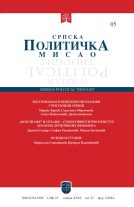- Home page
- Researchers
- Ivana Stepanović Ilić
Ivana Stepanović Ilić
Institute of Psychology, Faculty of Philosophy, University of Belgrade

Leisure Patterns and Values in Adolescents from Serbia born in 1990s: An Attempt at Building a Bridge between the Two Domains
This work is an attempt at empirically establishing a relation between leisure and values in adolescents. Being new, this topic could help a broader understanding of youth leisure and its association with inner psychological dispositions, but also with specific social context (prolonged economic crisis and post-war environment). Five typical leisure patterns were previously identified: academic, sports, going out, following celebrities in the media and music, and computers pattern. The main objective was to discover whether students with high and low scores on these patterns differ regarding their values. The sample consisted of 2426 Serbian secondary school students from 9 towns. A discriminant analysis was performed and showed that it was possible to identify a specific mix of personal and social values for every leisure pattern. This confirms the existence of a relation between students’ behaviour during free time and their values, expressed as a preference for specific personal and social goals. The resultss imply that connecting two domains is achievable and fruitful in both ways. The identified leisure patterns contribute to a more detailed and elaborate portrayal of adolescents’ values but those values also bring a new insight into specific features of adolescents' behaviour during leisure time.

Dropping Out: What Are Schools Doing To Prevent It?
This paper approaches the occurrence of dropout as a consequence of social and academic disengagement from school. Starting from this theoretical position, we analysed responses made by employees (principals, teachers, school counsellors) from primary and secondary schools regarding intervention actions undertaken when there is a risk of a student dropping out of school. The analysed data were collected by in-depth interviews and focus groups. Responses were then classified using thematic content analysis. The existing system of prevention programs s are most often not aimed at all aspects of this phenomenon and in the course of their implementation unsatisfactory level of cooperation between different institutions has been observed. The preventative actions constructed at school level, sometimes take the shape of pseudohelp for students in the form of justifying their absences from school or awarding them higher marks than they deserve. Prevention programs listed by employees are not aimed at increasing students’ social engagement despite a significant number of findings that prove the importance of this kind of integration.

Public Figures as Role Models of Serbian Adolescents: Who Are Idols and Why?
The work deals with public figures as role models of Serbian adolescents. We had three major goals: 1) to classify adolescents’ idols and compare data to previous studies; 2) to classify reasons for idols’ admiration and to relate them to specific role model types; 3) to test the relationship between idols’ preference and adolescents’ socio-demographic features. The sample was convenient and consisted of 1404 students from primary and secondary schools in 5 Serbian towns. The question regarding public role models and associated reasons was raised and pupils were asked to name a public figure they look up to and provide explanation why. The results show that: 1) Public figures from show business are the most popular; one new category (entrepreneurs) as a subcategory (you-tubers and bloggers within show business category) has been added to the earlier classification of role models, and there are changes in role model types preference indicating a value shift in Serbian adolescents; 2) Professional success of public figures is the most valued characteristic and sensible connection between types of idols and associated reasons is established by GLM ANOVA and logistic regressions; 3) the connection between idols’ preference and adolescents’ socio-demographic features is partly confirmed showing that those features are important for understanding adolescents’ role model choices. The results have been discussed in the light of previous research and the future directions of this topic investigation.
